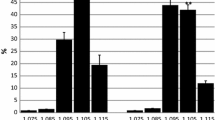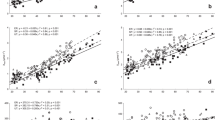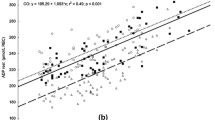Summary
The erythrocyte 2,3-diphosphoglycerate concentration (2,3-DPG) and the activity of red cell hexokinase, pyruvate kinase, glucose-6 phosphate dehydrogenase and gluthatione reductase were studied in 27 normal volunteers before and after 2 and 4 months of physical endurance training. The 4 months of training increased maximal oxygen uptake and physical working capacity (PWC130) by 16% (p<0.001) and 29% (p<0.001) respectively. Resting heart rate was decreased (p<0.001) by 11 beats·min−1. With 2 months of training the erythrocyte 2,3-DPG concentration increased by 9% (p<0.001); with 4 months training the increase was only 4% (p<0.05). The training-induced increase in red cell 2,3-DPG was not accompanied by enhanced activity of erythrocyte hexokinase, pyruvate kinase, glucose-6 phosphate dehydrogenase or glutathione reductase. It is concluded that the rise in red cell 2,3-DPG induced by physical endurance training is not due to activation of red cell glycolytic enzymes or the enzymes involved in the pentose-phosphate cycle
Similar content being viewed by others
References
Astrand PO, Rodahl K (1986) Physical performance. In: Textbook of work physiology; physiological bases of exercise. McGraw-Hill Book Company, New York, p 297
Bellingham AJ, Detter JC, Lenfant C (1971) Regulatory mechanisms of hemoglobin oxygen affinity in acidosis and alkalosis. J Clin Invest 50:700–706
Beutler E (1975) Red cell metabolism. A manual of biochemical methods. Grune and Stratton, New York
Böning D, Schweigart U, Tibes U, Hemmer B (1975) Influences of exercise and endurance training on the oxygen dissociation curve of blood under in vivo and in vitro conditions. Eur J Appl Physiol 34:1–10
Brodthagen UA, Nørregaard Hansen K, Bjerre Knudsen J, Jordal R, Kristensen O, Paulev PE (1985) Red cell 2,3-DPG, ATP, and mean cell volume in highly trained athletes. Eur J Appl Physiol 53:334–338
Fornaini G, Dacha M, Accorsi A, Fazi A, Piatti E (1981) Glucose utilization in human erythrocytes during physical exercise. Med Sci Sports Exerc 13:322–324
Karvonen MJ, Kentala K, Muslala O (1957) The effect of training on heart rate: a longitudinal study. Ann Med Exp Biol Fenn 35:307–315
Katz A, Sharp RL, King DS, Costill DL, Fink WJ (1984) Effect of high intensity interval training on 2,3-diphosphoglycerate at rest and after maximal exercise. Eur J Appl Physiol 52:331–335
Keitt AS (1971) Reduced nicotinamide adenine dinucleotidelinked analysis of 2,3-diphosphoglyceric acid:Spectrophotometric and fluorometric procedures. J Lab Clin Med 77:470–475
Lijnen P, Hespel P, Van Oppens S et al. (1986) Erythrocyte 2,3-diphosphoglycerate and serum enzyme concentrations in trained and sedentary men. Med Sci Sports Exerc 18:174–179
Mairbäurl H, Humpeler E, Schwaberger G, Pessenhofer H (1983) Training-dependent changes of red cell density and erythrocytic oxygen transport. J Appl Physiol 55:1403–1407
Mairbäurl H, Schobersberger W, Humpeler E, Hasibeder W, Fischer W, Raas E (1986) Beneficial effects of exercising at moderate altitude on red cell oxygen transport and on exercise performance. Pflügers Arch 406:594–599
Rand PW, Norton JM, Barker N, Lovell M (1973) Influence of athletic traning on hemoglobin-oxygen affinity. Am J Physiol 224:1334–1337
Reinhart WH, Stäubli M, Straub PW (1983) Impaired red cell filterability with elimination of old red blood cells during a 100 km race. J Appl Physiol 54:827–830
Remes K, Vuopio P, Härkönen M (1979) Effect of long-term training and acute physical exercise on red cell 2,3-diphosphoglycerate. Eur J Appl Physiol 42:199–207
Seaman C, Wyss S, Piomelli S (1980) The decline in energetic metabolism with aging of the erythrocyte and its relationship to cell death. Am J Hematol 8:31–42
Shappell SD, Murray JA, Bellingham AJ, Woodson RD, Detter JC, Lenfant C (1971) Adaptation to exercise: role of hemoglobin affinity for oxygen and 2,3-diphosphoglycerate. J Appl Physiol 30:827–832
Smalley KA, Runyan WS, Puhl JL (1981) Effect of training on erythrocyte 2,3-diphosphoglycerate in two groups of women cross-country runners. J Sports Med 21:352–358
Spodaryk K, Szygula Z, Dabrowski Z, Miszta H (1985) The activity of erythrocyte enzymes in rats subjected to running exercises. Eur J Appl Physiol 54:533–537
Author information
Authors and Affiliations
Rights and permissions
About this article
Cite this article
Hespel, P., Lijnen, P., Fagard, R. et al. Effects of training on erythrocyte 2,3-diphosphoglycerate in normal men. Europ. J. Appl. Physiol. 57, 456–461 (1988). https://doi.org/10.1007/BF00417993
Accepted:
Issue Date:
DOI: https://doi.org/10.1007/BF00417993




